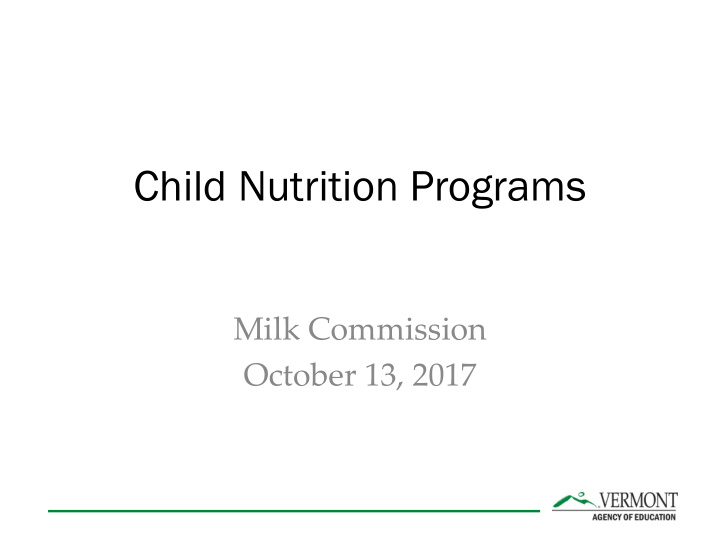



Child Nutrition Programs Milk Commission October 13, 2017
USDA USDA FNS Special Nutrition Programs SNP Supplemental Food Distribution Food Safety Child Nutrition Food Programs Division Division Division Division VT Agency of Education
VT Child Nutrition Programs • National School Lunch Program • School Breakfast Program • Child & Adult Care Food Program • Summer Food Service Program • After School Programs • Special Milk Program • USDA Foods Program • TEFAP
Federal Funds per Program Distribution of $35,000,000 School Meals & Snacks Child & Adult Care Food Program USDA Foods Fresh Fruit & Vegetable Program Summer Food Service Program $ 20,665,000
Healthy, Hunger Free Kids Act of 2010 • New Meal Pattern Standards for School Lunch & Breakfast • Nutrition Standards – Calories – Saturated Fat – Sodium – Trans Fat • Smart Snack Standards • Child Care Meal Nutrition Standards
Meal Patterns • Meal Components – Meat/Meat Alternate – Whole Grain Rich Item – Fruit – Vegetable – Milk
School Meals • Pre-School • Pre-K • Grades 1 – 12 • Technical Centers • Independent Schools • Private Schools • Residential Child Care Institutions
Meal Types • Breakfast • Lunch • After School Snack
Offer vs Serve • Students/children offered all meal components • Breakfast • must take a fruit or vegetable • may decline 1 item • Lunch • must take a fruit or vegetable • May decline 2 items • Share Tables
Weekly Lunch Requirements
Nutrition Standards • Lunch Daily Amount Based on WEEKLY Average Nutrients Grades K – 5 Grades 6 – 8 Grades 9 – 12 Calories 550 – 650 600 – 700 750 – 850 Saturated Fat < 10% <10% <10% Sodium ≤ 1230 mgs ≤ 1360 mgs ≤ 1420 mgs Nutritional label on manufacturer specifications must indicate zero Trans Fat grams of trans fat per serving
Nutrition Standards • Breakfast Daily Amount Based on WEEKLY Average Nutrients Grades K – 5 Grades 6 – 8 Grades 9 – 12 Calories 350 - 550 400 - 550 450 - 600 Saturated Fat < 10% <10% <10% Sodium ≤ 430 mgs ≤ 470 mgs ≤ 500 mgs Nutritional label on manufacturer specifications must indicate zero Trans Fat grams of trans fat per serving
Milk Component • 1 cup daily • Breakfast • Lunch – Low Fat Unflavored – 1% – Fat Free Unflavored – Fat Free Flavored – Milk Substitute – same nutrient contribution as cow’s milk
Meat/Meat Alternates • 1 – 2 oz. • Alternates – Cheese – 2 – 4 Oz. Cottage Cheese – 4 – 8 Yogurt, commercially prepared
Smart Snack Standards • Foods must also meet several nutrient requirements: • Calorie limits: – Snack items: ≤ 200 calories – Entrée items: ≤ 350 calories • Sodium limits: – Snack items: ≤ 200 mg – Entrée items: ≤ 480 mg • Fat limits: – Total fat: ≤35% of calories – Saturated fat: < 10% of calories – Trans fat: zero grams • Sugar limit: – ≤ 35% of weight from total sugars in foods
Beverages • Plain water (with or without carbonation) • Unflavored low fat milk • Unflavored or flavored fat free milk and milk alternatives permitted by NSLP/SBP • 100% fruit or vegetable juice and • 100% fruit or vegetable juice diluted with water (with or without carbonation), and no added sweeteners. Elementary schools may sell up to 8-ounce portions. Middle schools and high schools may sell up to 12-ounce portions of milk and juice. There is no portion size limit for plain water.
No & Low Calorie Beverages High School Students • No more than 20-ounce portions of – Calorie-free, flavored water (with or without carbonation); and – Other flavored and/or carbonated beverages that are labeled to contain < 5 calories per 8 fluid ounces or ≤ 10 calories per 20 fluid ounces. • No more than 12-ounce portions of – Beverages with ≤ 40 calories per 8 fluid ounces, or ≤ 60 calories per 12 fluid ounces.
Child & Adult Care Food Program • Children – Ages 1 to 18 • Adults – In respite care – Mentally and Physically Disabled
Meals Served • Breakfast • Lunch • Snack • Supper • At-Risk Suppers – schools/child care programs
Fluid Milk Cows Milk 12 – 24 months 2 – 5 years 6 years and older Whole Unflavored 1% Unflavored Skim/ Fat Free Unflavored Skim/ Fat Free Flavored
Meat/Meat Alternates • Cheese • Yogurt – No more than 23g sugar per 6 oz. serving
Summer Food Service Program • June – August • School is Out • Disasters & Other Events
Meals Offered • Breakfast • Lunch • Snack • Supper
Fluid Milk • Non-fat, Skim • Low-fat • Whole Milk • Flavored Milk • All 8 oz. portions
USDA Foods • All Schools with Lunch Programs • .2325 per lunch, plus .10 per meal provision • Shredded Mozzarella, Reduced-Fat Cheddar, Processed Sliced American, Mozzarella Cheese Sticks, Yogurt • TEFAP – UHT Milk, 32 oz. containers
Milk Volume Gallons of Milk Per Program 500,000 450,000 400,000 350,000 300,000 485,941 250,000 200,000 150,000 254,775 100,000 50,000 25,147 16,844 2,390 0 SMP SFSP CACFP NSLP SBP
Challenges • Storage – Walk in coolers, Milk Coolers • Cows vs Cartons • Share Tables • Competitive Beverages • Food Safety • Flavored vs Non-Flavored Bias • Milk vs Water
Cows vs Cartons • • Serving Sizes Recycling Cartons • • Portability Storage • • Space in Serving Line Milk Coolers • • Glasses > Labor & Share Tables Dishwashing • Maintaining • Storage Temperature • • Container Weight Opening Cartons • • Meals in Classroom Convenient for Grab & Go/Meals in • Cleaning Classroom
• Laurie Colgan Director of Child Nutrition Programs VT Agency of Education Laurie.Colgan@Vermont.gov (802) 479-1187 This institution is an equal opportunity provider.
Recommend
More recommend